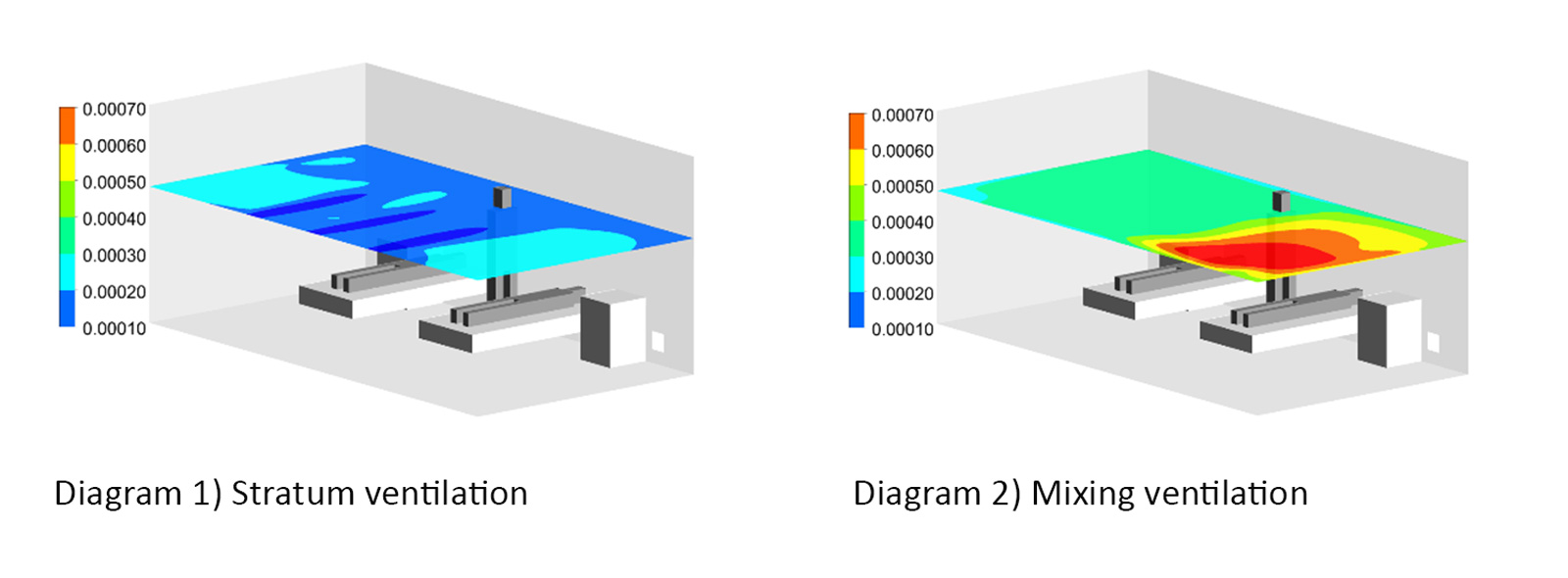New ventilation system helps protect healthcare workers from Covid-19 infection

An innovative ventilation system, called stratum ventilation, developed in the Division of Building Science and Technology (BST) at City University of Hong Kong (CityU) can help reduce the risk of Covid-19 infection by supplying fresher air for healthcare staff in isolation wards.
The stratum ventilation was developed by Professor John Lin Zhang, Head of BST, who has been studying ventilation systems since the outbreak of SARS in 2003. The air supply and exhaust for the stratum ventilation system can be placed strategically in different positions for a particular functional location. The supply can be placed in the middle of a wall while the exhaust can be placed near the floor, thus minimising the mixing of fresh and obsolete air in a hospital ward.
In contrast, conventional mixing ventilation usually has both the air supply and exhaust vents at the ceiling, which means that the fresh and obsolete air mixes up before being delivered to the room occupants for inhalation.
“Position the healthcare workers upstream in the supply airflow and dilute their breathing zone (1.3 – 1.7 m above the floor) effectively are very important,” said Professor Lin. “Mixing ventilation commonly used in isolation wards mixes fresh and obsolete air together as both the supply air diffusers and exhaust louvres are at the ceiling. The supply airflow usually goes around under ceiling first because of the pressure difference, and as it does so, it mixes with the older air before it is removed through the exhaust vent, then coming down to the breathing zone of the healthcare workers.”
Thus, the fresh air supplied by the ceiling diffusers may not be able to dilute the air that has remained in the breathing zone for some time.
“This means that the healthcare workers in the wards may inhale the air contaminated with pathogens,” said Professor Lin.
With the CityU ventilation system, the height of the supply terminals depends on the function of the room. For example, in a hospital ward, the supply terminals should be installed at the height of 1.5 m above the floor, which is the average height of a person’s nose from the ground when she or he is standing. A difference of 1 m along the height from the patient lying on a bed means that healthcare workers can inhale fresher air if the stratum ventilation system is applied.
“The system allows the fresh air to flow out horizontally, where it first reaches the breathing zone of the healthcare workers and then that of the patients. Finally, the air stream with possible pathogens is exhausted through the outlets above the floor near the patients’ headboards. This not only positions healthcare workers in the ‘upstream’ part of the supply airflow, but also dilutes and expels the airborne contaminants in the ward effectively,” Professor Lin said.
Professor Lin and his research team have conducted feasibility studies for isolation wards using experiments and computational fluid dynamics simulations. The simulations use different modes of supplying and exhausting air in a room. The distribution and concentration of droplets one minute after a patient coughed in a ward were studied. It was found that the stratum ventilation (Diagram 1) had the best performance out of different systems because of a lower concentration of droplets and more even distribution. No area of prominently high concentration was found.
However, if a mixing ventilation system (Diagram 2) was adopted, part of the walk route in the ward was contaminated. Healthcare workers, who stay or pass through this area, have a high risk of infection because of the high droplet concentration.
“We need to protect healthcare workers as they are the frontline soldiers fighting the epidemic. In addition to personal protective equipment, the stratum ventilation system can supply fresher air and effectively dilute the concentration of pathogens, which will provide double protection for healthcare workers,” emphasized Professor Lin.
